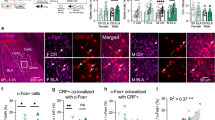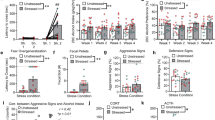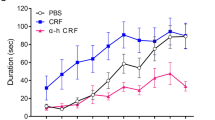Abstract
Hyperalgesia is an exaggerated response to noxious stimuli produced by peripheral or central plasticity. Stress modifies nociception, and humans with post-traumatic stress disorder (PTSD) exhibit co-morbid chronic pain and amygdala dysregulation. Predator odor stress produces hyperalgesia in rodents. Systemic blockade of corticotropin-releasing factor (CRF) type 1 receptors (CRFR1s) reduces stress-induced thermal hyperalgesia. We hypothesized that CRF-CRFR1 signaling in central amygdala (CeA) mediates stress-induced hyperalgesia in rats with high stress reactivity. Adult male Wistar rats were exposed to predator odor stress in a conditioned place avoidance paradigm and indexed for high (Avoiders) and low (Non-Avoiders) avoidance of predator odor-paired context, or were unstressed Controls. Rats were tested for the latency to withdraw hindpaws from thermal stimuli (Hargreaves test). We used pharmacological, molecular, and immunohistochemical techniques to assess the role of CRF-CRFR1 signaling in CeA in stress-induced hyperalgesia. Avoiders exhibited higher CRF peptide levels in CeA that did not appear to be locally synthesized. Intra-CeA CRF infusion mimicked stress-induced hyperalgesia. Avoiders exhibited thermal hyperalgesia that was reversed by systemic or intra-CeA injection of a CRFR1 antagonist. Finally, intra-CeA infusion of tetrodotoxin produced thermal hyperalgesia in unstressed rats and blocked the anti-hyperalgesic effect of systemic CRFR1 antagonist in stressed rats. These data suggest that rats with high stress reactivity exhibit hyperalgesia that is mediated by CRF-CRFR1 signaling in CeA.
Similar content being viewed by others
Log in or create a free account to read this content
Gain free access to this article, as well as selected content from this journal and more on nature.com
or
References
Asmundson GJ, Katz J (2009). Understanding the co-occurrence of anxiety disorders and chronic pain: state-of-the-art. Depress Anxiety 26: 888–901.
Bajo M, Cruz MT, Siggins GR, Messing R, Roberto M (2008). Protein kinase C epsilon mediation of CRF- and ethanol-induced GABA release in central amygdala. Proc Natl Acad Sci USA 105: 8410–8415.
Bale TL, Vale WW (2004). CRF and CRF receptors: role in stress responsivity and other behaviors. Annu Rev Pharmacol Toxicol 44: 525–557.
Bourgeais L, Gauriau C, Bernard JF (2001). Projections from the nociceptive area of the central nucleus of the amygdala to the forebrain: a PHA-L study in the rat. Eur J Neurosci 14: 229–255.
Braz JM, Nassar MA, Wood JN, Basbaum AI (2005). Parallel ‘pain’ pathways arise from subpopulations of primary afferent nociceptor. Neuron 47: 787–793.
Butler RK, Finn DP (2009). Stress-induced analgesia. Prog Neurobiol 88: 184–202.
Crettaz B, Marziniak M, Willeke P, Young P, Hellhammer D, Stumpf A et al (2013). Stress-induced allodynia—evidence of increased pain sensitivity in healthy humans and patients with chronic pain after experimentally induced psychosocial stress. PLoS One 8: e69460.
Crock LW, Kolber BJ, Morgan CD, Sadler KE, Vogt SK, Bruchas MR et al (2012). Central amygdala metabotropic glutamate receptor 5 in the modulation of visceral pain. J Neurosci 32: 14217–14226.
Crown ED, King TE, Meagher MW, Grau JW (2000). Shock-induced hyperalgesia: III. Role of the bed nucleus of the stria terminalis and amygdaloid nuclei. Behav Neurosci 114: 561–573.
Dafny N, Dong WQ, Prieto-Gomez C, Reyes-Vazquez C, Stanford J, Qiao JT (1996). Lateral hypothalamus: site involved in pain modulation. Neuroscience 70: 449–460.
Defrin R, Ginzburg K, Solomon Z, Polad E, Bloch M, Govezensky M et al (2008). Quantitative testing of pain perception in subjects with PTSD—implications for the mechanism of the coexistence between PTSD and chronic pain. Pain 138: 450–459.
Dickie EW, Brunet A, Akerib V, Armony JL (2008). An fMRI investigation of memory encoding in PTSD: influence of symptom severity. Neuropsychologia 46: 1522–1531.
Dina OA, Levine JD, Green PG (2011). Enhanced cytokine-induced mechanical hyperalgesia in skeletal muscle produced by a novel mechanism in rats exposed to unpredictable sound stress. Eur J Pain 15: 796–800.
Edwards S, Baynes BB, Carmichael CY, Zamora-Martinez ER, Barrus M, Koob GF et al (2013). Traumatic stress reactivity promotes excessive alcohol drinking and alters the balance of prefrontal cortex-amygdala activity. Transl Psychiatry 3: e296.
Fu Y, Neugebauer V (2008). Differential mechanisms of CRF1 and CRF2 receptor functions in the amygdala in pain-related synaptic facilitation and behavior. J Neurosci 28: 3861–3876.
Gilpin NW, Herman MA, Roberto M (2015). The central amygdala as an integrative hub for anxiety and alcohol use disorders. Biol Psychiatry 77: 859–869.
Gray TS, Magnuson DJ (1992). Peptide immunoreactive neurons in the amygdala and the bed nucleus of the stria terminalis project to the midbrain central gray in the rat. Peptides 13: 451–460.
Heilig M, Koob GF, Ekman R, Britton KT (1994). Corticotropin-releasing factor and neuropeptide Y: role in emotional integration. Trends Neurosci 17: 80–85.
Huang MM, Overstreet DH, Knapp DJ, Angel R, Wills TA, Navarro M et al (2010). Corticotropin-releasing factor (CRF) sensitization of ethanol withdrawal-induced anxiety-like behavior is brain site specific and mediated by CRF-1 receptors: relation to stress-induced sensitization. J Pharmacol Exp Ther 332: 298–307.
Jasmin L, Burkey AR, Card JP, Basbaum AI (1997). Transneuronal labeling of a nociceptive pathway, the spino-(trigemino-)parabrachio-amygdaloid, in the rat. J Neurosci 17: 3751–3765.
Ji G, Fu Y, Adwanikar H, Neugebauer V (2013). Non-pain-related CRF1 activation in the amygdala facilitates synaptic transmission and pain responses. Mol Pain 9: 1–16.
Johnson AC, Tran L, Greenwood-Van Meerveld B (2015). Knockdown of corticotropin-releasing factor in the central amygdala reverses persistent viscerosomatic hyperalgesia. Transl Psychiatry 5: e517.
Justice NJ, Yuan ZF, Sawchenko PE, Vale W (2008). Type 1 corticotropin-releasing factor receptor expression reported in BAC transgenic mice: implications for reconciling ligand-receptor mismatch in the central corticotropin-releasing factor system. J Comp Neurol 511: 479–496.
Karanikas CA, Lu Y-L, Richardson HN (2013). Adolescent drinking targets corticotropin-releasing factor peptide-labeled cells in the central amygdala of male and female rats. Neuroscience 249: 98–105.
Latremoliere A, Woolf CJ (2009). Central sensitization: a generator of pain hypersensitivity by central neural plasticity. J Pain 10: 895–926.
Lau BK, Vaughan CW (2014). Descending modulation of pain: the GABA disinhibition hypothesis of analgesia. Curr Opin Neurobiol 29: 159–164.
Lew HL, Otis JD, Tun C, Kerns RD, Clark ME, Cifu DX (2009). Prevalence of chronic pain, posttraumatic stress disorder, and persistent postconcussive symptoms in OIF/OEF veterans: polytrauma clinical triad. J Rehabil Res Dev 46: 697–702.
Li C, Yang Y, Liu S, Fang H, Zhang Y, Furmanski O et al (2014). Stress induces pain transition by potentiation of AMPA receptor phosphorylation. J Neurosci 34: 13737–13746.
McDonald AJ (1989). Coexistence of somatostatin with neuropeptide Y, but not with cholecystokinin or vasoactive intestinal peptide, in neurons of the rat amygdala. Brain Res 500: 37–45.
Millan MJ (2002). Descending control of pain. Prog Neurobiol 66: 355–474.
Moeller-Bertram T, Keltner J, Strigo IA (2012). Pain and post traumatic stress disorder - review of clinical and experimental evidence. Neuropharmacology 62: 586–597.
Morey RA, Dolcos F, Petty CM, Cooper DA, Hayes JP, LaBar KS et al (2009). The role of trauma-related distractors on neural systems for working memory and emotion processing in posttraumatic stress disorder. J Psychiatr Res 43: 809–817.
Neugebauer V, Li W (2003). Differential sensitization of amygdala neurons to afferent inputs in a model of arthritic pain. J Neurophysiol 89: 716–727.
Neugebauer V, Li W, Bird GC, Han JS (2004). The amygdala and persistent pain. Neuroscientist 10: 221–234.
Oliveira MA, Prado WA (2001). Role of PAG in the antinociception evoked from the medial or central amygdala in rats. Brain Res Bull 54: 55–63.
Orr SP, Metzger LJ, Lasko NB, Macklin ML, Peri T, Pitman RK (2000). De novo conditioning in trauma-exposed individuals with and without posttraumatic stress disorder. J Abnorm Psychol 109: 290–298.
Paxinos G, Watson C (2005) The Rat Brain in Stereotaxic Coordinates. Elsevier Academic Press: San Diego, CA, USA.
Rauch SL, Whalen PJ, Shin LM, McInerney SC, Macklin ML, Lasko NB et al (2000). Exaggerated amygdala response to masked facial stimuli in posttraumatic stress disorder: a functional MRI study. Biol Psychiatry 47: 769–776.
Regev L, Tsoory M, Gil S, Chen A (2012). Site-specific genetic manipulation of amygdala corticotropin-releasing factor reveals its imperative role in mediating behavioral response to challenge. Biol Psychiatry 71: 317–326.
Roltsch EA, Baynes BB, Mayeux JP, Whitaker AM, Baiamonte BA, Gilpin NW (2014). Predator odor stress alters corticotropin-releasing factor-1 receptor (CRF1R)-dependent behaviors in rats. Neuropharmacology 79: 83–89.
Sakanaka M, Shibasaki T, Lederis K (1986). Distribution and efferent projections of corticotropin-releasing factor-like immunoreactivity in the rat amygdaloid complex. Brain Res 382: 213–238.
Semple WE, Goyer PF, McCormick R, Donovan B, Muzic RF Jr, Rugle L et al (2000). Higher brain blood flow at amygdala and lower frontal cortex blood flow in PTSD patients with comorbid cocaine and alcohol abuse compared with normals. Psychiatry 63: 65–74.
Shi C, Davis M (1999). Pain pathways involved in fear conditioning measured with fear-potentiated startle: lesion studies. J Neurosci 19: 420–430.
Shipherd JC, Keyes M, Jovanovic T, Ready DJ, Baltzell D, Worley V et al (2007). Veterans seeking treatment for posttraumatic stress disorder: what about comorbid chronic pain? J Rehabil Res Dev 44: 153–166.
Swanson LW, Sawchenko PE, Rivier J, Vale WW (1983). Organization of ovine corticotropin-releasing factor immunoreactive cells and fibers in the rat brain: an immunohistochemical study. Neuroendocrinology 36: 165–186.
Werka T (1994). Post-stress analgesia in rats with partial amygdala lesions. Acta Neurobiol Exp 54: 127–132.
Werka T, Marek P (1990). Post-stress analgesia after lesions to the central nucleus of the amygdala in rats. Acta Neurobiol Exp (Wars) 50: 13–22.
Whitaker AM, Gilpin NW (2015). Blunted hypothalamo-pituitary adrenal axis response to predator odor predicts high stress reactivity. Physiol Behav 147: 16–22.
Uryu K, Okumura T, Shibasaki T, Sakanaka M (1992). Fine structure and possible origins of nerve fibers with corticotropin-releasing factor-like immunoreactivity in the rat central amygdaloid nucleus. Brain Res 577: 175–179.
Acknowledgements
We thank Dimitri Grigoriadis of Neurocrine for generous donation of R121919 and Dr Wylie Vale of the Salk Institute for his generous donation of the CRF antisera. We thank Marina Shirokova and Dimitra Gomes for their technical assistance with these studies. Dr Gilpin is a consultant for Glauser Life Sciences.
Author information
Authors and Affiliations
Corresponding author
Additional information
Supplementary Information accompanies the paper on the Neuropsychopharmacology website
Supplementary information
Rights and permissions
About this article
Cite this article
Itoga, C., Roltsch Hellard, E., Whitaker, A. et al. Traumatic Stress Promotes Hyperalgesia via Corticotropin-Releasing Factor-1 Receptor (CRFR1) Signaling in Central Amygdala. Neuropsychopharmacol 41, 2463–2472 (2016). https://doi.org/10.1038/npp.2016.44
Received:
Revised:
Accepted:
Published:
Issue date:
DOI: https://doi.org/10.1038/npp.2016.44
This article is cited by
-
Traumatic Stress-Enhanced Alcohol Drinking: Sex Differences and Animal Model Perspectives
Current Addiction Reports (2024)
-
Examining sex differences in responses to footshock stress and the role of the metabotropic glutamate receptor 5: an [18F]FPEB and positron emission tomography study in rats
Neuropsychopharmacology (2023)
-
Effects of Glucocorticoid Hormones on Pain Sensitivity: Involvement of Glucocorticoid and Mineralocorticoid Receptors
Neuroscience and Behavioral Physiology (2023)
-
Rodent models of post-traumatic stress disorder: behavioral assessment
Translational Psychiatry (2020)



